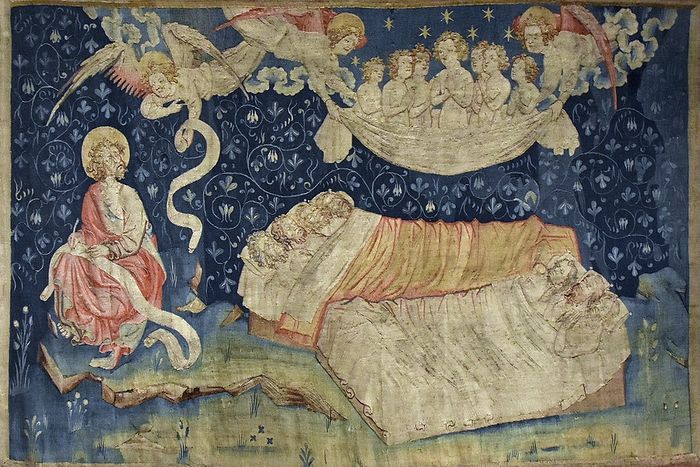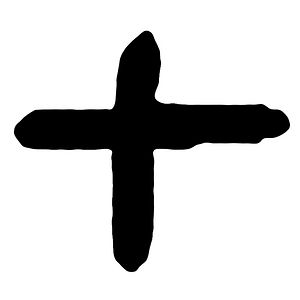 “The Sleep of the Just” panel of the unique fourteenth-century Apocalypse Tapestry, Chateau d’Angers, France.
“The Sleep of the Just” panel of the unique fourteenth-century Apocalypse Tapestry, Chateau d’Angers, France. Almost all believers have heard about “the seal of the antichrist”. Many sincerely think that it was mentioned in the Book of the Revelation by St. John the Theologian, but it is not so. You cannot find the word combination “the seal of the antichrist” in the Bible. St. John in the Apocalypse does mention “the mark of the antichrist” (or “the sign of the antichrist”), but it is not the same. Though the terms “the seal” and “the mark” are very similar, they are nevertheless different [here the author is speaking about two Russian words: “pechat” and “nachertanye”; the former in various contexts may mean “a seal”, “a stamp”, while the latter apart from “a seal” may mean “an inscription”, “tracing” etc. In the given context their meaning is indeed very similar].
The Greek word “haragma”, meaning “a seal”, “a mark”, “a sign”, is used in chapter 13 of the Greek version of the Revelation. But there is also another Greek term used in the book – “sphragis”, meaning “a seal”, “an identifying sign or character” (hence: sphragistics—the study of seals and signet rings). But the word “seal” is used in the Bible in relation to God, not the antichrist. So the wording of the last book of the New Testament is the following: “the seal of God” and “the mark of the antichrist”.
All of us have heard about “the seal of the antichrist” many times, albeit it cannot be found in the Bible. Meanwhile, almost nobody talks about “the seal of the Creator” which is mentioned in the Bible. Strange enough, Christians tend to find talks about Christ “boring”, whereas many of them are interested in “horror stories” related to the antichrist and devil… So let us now talk about “the seal of God” in order to counter this odd tendency.
It is mentioned in the following verses of the Book of the Apocalypse:
And I saw another angel ascending from the east, having the seal of the living God: and he cried with a loud voice to the four angels, to whom it was given to hurt the earth and the sea, saying, Hurt not the earth, neither the sea, nor the trees, till we have sealed the servants of our God in their foreheads (Rev. 7:2-3).
Thus, an angel who has the seal of the living God was sent by Him to seal the servants of the Almighty before the antichrist’s persecutions. What does this “sealing” mean?
Seals were widely used in the ancient world. First of all, a seal signified ownership, belonging. For example, cattle and slaves were sealed for the identification of their owners. Merchants would seal their bales with goods and wine growers would seal their wine jugs for the same purpose. Seals served as a form of identification of owners and the quality of products. Taking into account these symbols, who are those sealed by God? These are the servants of the Almighty that in some sense represent their Master.
Royal seals in the ancient world are another particular theme. Eastern rulers had seal rings (also called signet rings) that they used to certify their documents and mark their personal things. When Pharaoh appointed Joseph ruler over Egypt, he took off his ring (a token of his power) and put it on Joseph’s hand (see Gen. 41:42). Similarly, King Artaxerxes took off his ring and gave it into the hands of Haman, and when the latter lost power the signet ring was handed to Mordecai (see Esth. 3:10; 8:2). King Darius sealed the den where Prophet Daniel was thrown with his own signet ring (see Dan. 6:17). After the Crucifixion and Entombment of Christ the chief priests and the Pharisees made the Sepulcher secure by putting a seal on the stone (see Mt. 27:66). Thus we come to the conclusion that sealing of the faithful means their belonging to the Heavenly Father Who protects them and confers upon them spiritual authority (the latter is applicable to clergy as they can “bind and loose”).
In the early Church “the seal” acquired a liturgical meaning. First of all, it was associated with the sacrament of Baptism. Truly Baptism is a kind of “seal of God” indicating that a baptized person becomes the property and possession of the Lord. The Holy Baptism also marks the radical transformation of somebody’s heart that has already occurred by the Divine grace. In fact in the first several centuries of Christianity most of those being baptized were adults who would have a long time of preparation before Baptism, profess their faith and answer several questions to a bishop. Baptism was a seal that was received by people who had already come to believe in Christ and had been transformed morally. This sacrament is also interpreted as “sealing” in a number of epistles of Apostle Paul (see 2 Cor. 1:22; Eph. 1:13 and 4:30). Therefore, “those sealed by God” are those who were baptized.
The sacrament of Chrismation is “the spiritual seal” too. Apostle Paul said more than once that a Christian is sealed by the Holy Spirit. You can find the following statements in the holy apostle’s epistles:
-
Ye were sealed with that holy Spirit of promise (Eph. 1:13);
-
And grieve not the holy Spirit of God, whereby ye are sealed unto the day of redemption (Eph. 4:30);
-
Who hath also sealed us, and given the earnest of the Spirit in our hearts (2 Cor. 1:22).
In ancient times believers received the Holy Spirit through the laying on of hands (performed by a bishop), and in modern times it is done through Chrismation. Today the priest administering the sacrament of Chrismation with holy oil says, “The Seal and Gift of the Holy Spirit.” If we understand “sealing” as “anointing with chrism”, then the angel sealing the servants of God can be compared with a bishop or a priest who performs Chrismation.
According to the exegetists, there can be one more interpretation of “the seal of God”. We read in the Book of Ezekiel:
And the glory of the God of Israel was gone up from the cherub, whereupon he was, to the threshold of the house. And he called to the man clothed with linen, which had the writer's inkhorn by his side; And the Lord said unto him, Go through the midst of the city, through the midst of Jerusalem, and set a mark upon the foreheads of the men that sigh and that cry for all the abominations that be done in the midst thereof (Ezek. 9:3-4).
In the Hebrew Bible we read not “set a mark”, but “set a mark tav”. “Tav” was the last letter of the ancient Hebrew alphabet that used to be written as a small cross in ancient times.
“Sealing” of Christians at the time of the antichrist probably means that the Lord will help them bear their personal cross of Christian piety and faithfulness to the Creator with faith and patience. “The seal of the Life-Giving Cross will distinguish the unfaithful from the faithful, who will bear the sign of Christ before them unashamed and with boldness,”1 St. Andrew of Caesarea wrote. “The Cross is a prefiguration of the salvation to come, and… it signifies the end, the last letter being a sign of the final choice,” the martyred Fr. Daniel Sysoev explained.
In addition, there are other possible interpretations of marking the faithful ones with the seal of God.
“This seal is imprinting of Divine grace on the best and the worthiest of the Christian Church members, which, transforming their souls, will transform their appearance as well – that is, their brows,” wrote Alexander Lopukhin in his Explanatory Bible.
Some other commentators speak of “the seal of martyrdom”. Others interpret it as being chosen, blessed or protected by God. Many presume that it is the seal of the Christian faith that will be received by many Jews shortly before the Second Coming, according to the prophecy of St. Paul (see Rom. 11:26). The enumeration of the tribes of Israel in chapter 7 of the Revelation (see Rev. 7:4-8) suggests an idea that “the sealed servants of God” are Jewish converts to Christianity.
If we associate the verse Rev. 7:2-3 with Rev. 22:4, which reads …They shall see His Face; and His Name shall be in their foreheads in reference to those saved, then, according to our exegetists, “the Name of God” on foreheads may imply a perpetual memory of the Lord, an unceasing communion with Him, a special closeness to the Savior and an inextinguishable love for Him.
Thus, we have found so many different interpretations of the Biblical “seal of God”! It would seem that these questions should concern every sincere believer above all: what is the seal of God? How can we receive and keep it? But, alas, many of us are more interested in the antichrist with his horrors than in Christ. I recall how in the late 1990s Fr. Andrei Kuraev recounted that he had asked people in many towns, “Do you want to talk about Christ or about the antichrist?” and most of them had answered him, “About the antichrist!” I think that even today if we put up two posters in one or another town, reading “A famous theologian N. is going to deliver a lecture on Christ” and “A famous theologian N.N. is going to deliver a lecture on the antichrist”, the majority of people will come to listen to the theologian N.N.
Truly, there is such flaw in our Church consciousness that has to do with our lack of love for Christ. A genuine interest in the Holy Scriptures, an active participation in the Divine Liturgy, spiritual labor, keeping the commandments, and an in-depth study of our faith will be able to heal this spiritual disease. Reading Church commentaries on the Apocalypse can be strongly recommended to any Orthodox believer as well. And apart from chapter 13 of the Book of the Revelation, which speaks of the mark of the beast, one should pay special attention to chapter 7 which speaks of the seal of the living God. He who has the seal of God will never agree to take the mark of the antichrist, and he who really loves Christ will never betray Him.





http://orthodoxinfo.com/general/beast666.aspx